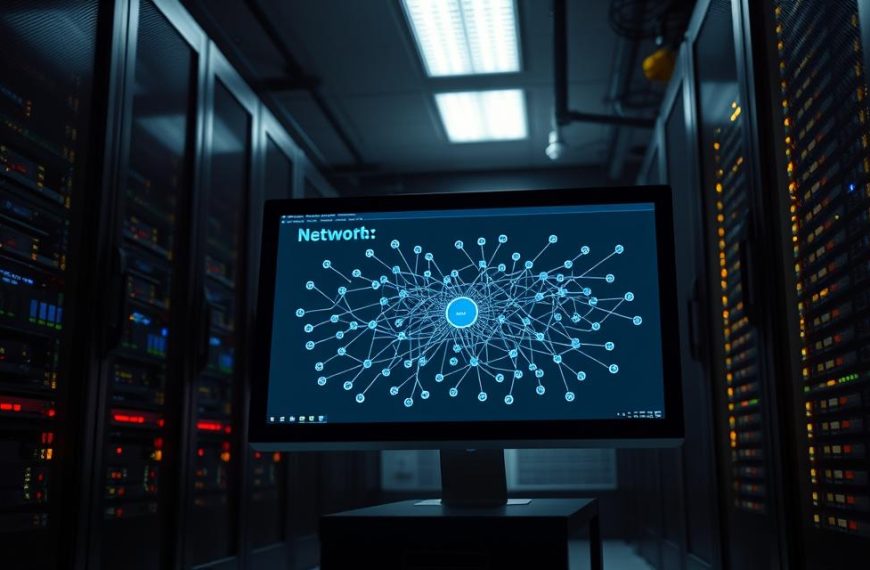In today’s digital age, computer network operations (CNO) play a vital role in safeguarding modern ecosystems. Defined by the triad of attack, defense, and exploitation, CNO ensures the security and resilience of critical systems. Originally developed by the Department of Defense in the 1990s, this framework remains foundational in both military and corporate strategies.
Nearly 96% of Fortune 500 companies rely on CNO principles to protect their data and infrastructure. This approach has fueled the global cybersecurity market, now valued at $2.7 trillion. By integrating advanced technology and strategic planning, CNO bridges the gap between military tactics and corporate IT security.
As networks grow more complex, the importance of robust network operations continues to rise. Whether defending against cyber threats or enhancing system performance, CNO remains a cornerstone of modern digital defense.
What Is Computer Network Operations? A Comprehensive Definition
From its military roots, the framework for protecting digital infrastructure has expanded globally. Originally developed by the Department of Defense in the 1990s, computer network operations (CNO) were designed to address emerging threats in the digital age. The 1998 DoD definition, “Military operations…to attack, defend, exploit,” laid the groundwork for modern cybersecurity practices.
Origins and Evolution of CNO
The origins of CNO trace back to the 1970s, when ARPANET security protocols were first implemented by the Defense Department. These early efforts focused on safeguarding military communications. Over time, CNO evolved through significant events like Operation Eligible Receiver (1997) and Moonlight Maze (1998), which highlighted vulnerabilities in national security systems.
Post-9/11, CNO expanded to protect critical infrastructure, including energy grids and financial systems. The 2015 CNSSI standardization further integrated cyber-physical systems, solidifying CNO’s role in modern defense strategies.
Key Components of CNO
CNO relies on three core components to ensure robust security:
- Network Architecture: The foundation for secure communication and data transfer.
- Cryptographic Systems: Essential for encrypting sensitive information and maintaining control over access.
- Intrusion Detection: Advanced tools to identify and mitigate potential threats in real-time.
Modern implementations, such as Operation Olympic Games (Stuxnet), demonstrate the effectiveness of CNO in both military and civilian contexts. While military applications focus on national defense, civilian uses prioritize protecting corporate systems and sensitive data.
The Three Pillars of Computer Network Operations
Effective cybersecurity hinges on three essential methodologies. These strategies—attack, defense, and exploitation—form the backbone of modern digital protection. Each plays a unique role in safeguarding systems and data from evolving threats.
Offensive Strategies: Network Attack
Offensive tactics focus on identifying and neutralizing threats before they cause harm. For example, the Lazarus Group’s 2023 campaign against blockchain networks resulted in $620 million in losses. State-sponsored attacks often target industrial control systems, with 73% of incidents reported by ICS-CERT.
These capabilities are not limited to military use. Corporate red teams employ similar methodologies to test system vulnerabilities. The NSA’s TAO unit, for instance, demonstrates how advanced network attack techniques can be applied in both government and private sectors.
Defensive Measures: Network Defense
Defensive strategies aim to protect systems from breaches and intrusions. The Colonial Pipeline ransomware attack in 2021 highlighted the importance of rapid response. NIST SP 800-160v2 outlines best practices for safeguarding critical infrastructure, emphasizing real-time threat detection.
Since 2020, zero-day detections have increased by 200%, according to NIST. This underscores the growing need for robust network defense mechanisms. Effective defense requires continuous monitoring and proactive measures to mitigate risks.
Exploitation Techniques: Network Exploitation
Exploitation involves gathering intelligence to prevent future threats. The SolarWinds breach, which affected 18,000 organizations, showcased advanced credential harvesting techniques. Mandiant estimates that 78% of advanced persistent threats rely on such methods.
These exploitation tactics are critical for understanding adversary behavior. By analyzing patterns, organizations can enhance their capabilities to predict and counter potential attacks.
| Strategy | Focus | Example |
|---|---|---|
| Network Attack | Neutralizing threats | Lazarus Group’s blockchain campaign |
| Network Defense | Protecting systems | Colonial Pipeline ransomware response |
| Network Exploitation | Gathering intelligence | SolarWinds credential harvesting |
Why Are Computer Network Operations Important?
Modern digital ecosystems rely heavily on advanced strategies to maintain stability and protection. Computer network operations (CNO) are essential for safeguarding critical infrastructure and ensuring the resilience of vital systems. With 93% of critical infrastructure using CNO frameworks, their importance is undeniable.
The Department of Homeland Security reports that CNO frameworks are integral to national security. These strategies protect energy grids, financial systems, and healthcare networks from cyber threats. The Department of Defense has allocated $15.6 billion to enhance CNO capabilities by 2025, reflecting their strategic value.
Role in Cybersecurity
CNO plays a pivotal role in defending against cyberattacks. Financial institutions using active defense strategies report a 400% return on investment. The MITRE ATT&CK framework serves as a blueprint for implementing CNO, enabling organizations to identify and mitigate threats effectively.
For example, Ukraine’s success in countering Russian cyberattacks from 2022 to 2024 highlights the effectiveness of CNO. By leveraging advanced security measures, they minimized disruptions to critical systems.
Applications in National Defense
In national defense, CNO is a cornerstone of modern strategies. The Pentagon’s Joint Cyber Command employs 6,200 specialists dedicated to CNO projects. Their work ensures the protection of military communications and operational systems.
The FDA’s cybersecurity mandates for medical devices further demonstrate CNO’s importance. By integrating CNO principles, manufacturers can safeguard sensitive information and ensure patient safety.
| Application | Impact | Example |
|---|---|---|
| Cybersecurity | 400% ROI for financial institutions | MITRE ATT&CK framework |
| National Defense | Protection of military systems | Pentagon’s Joint Cyber Command |
| Healthcare | FDA cybersecurity mandates | Medical device protection |
How Computer Network Operations Are Applied in Industry
Across industries, advanced strategies are reshaping how organizations protect their digital assets. From corporate giants to government agencies, these methods ensure resilience against evolving threats. By leveraging cutting-edge technology, businesses and institutions enhance their capabilities to safeguard critical systems.
Case Studies in Corporate Security
Corporate environments are prime targets for cyber threats, making robust network defenses essential. Microsoft’s response to the Storm-0558 breach in 2023 exemplifies effective CNO implementation. By isolating compromised systems and deploying advanced threat detection tools, they minimized damage and restored operations swiftly.
Amazon AWS Shield is another commercial example of network defense. This service protects cloud-based applications from DDoS attacks, ensuring uninterrupted service for millions of users. Such solutions highlight the importance of integrating CNO principles into corporate technology strategies.
Lockheed Martin’s Cyber Kill Chain model, adopted by 89% of Fortune 100 companies, demonstrates the scalability of CNO frameworks. This approach identifies and mitigates threats at every stage, from reconnaissance to data exfiltration.
Government and Military Applications
In the public sector, CNO plays a critical role in national security. The NSA’s operations against terrorist financing networks showcase the strategic use of network exploitation. By disrupting financial flows, these efforts weaken adversarial capabilities and enhance global safety.
Israel’s Unit 8200 is renowned for its CNO expertise. Their operations against Hamas cyber units have successfully neutralized threats to critical infrastructure. These efforts underscore the importance of proactive network defense in military contexts.
The FDA’s cybersecurity framework for medical devices integrates CNO principles to protect sensitive patient data. By enforcing stringent standards, they ensure the safety and reliability of healthcare technology.
- Microsoft’s CNO Response: Swift isolation and threat detection during the Storm-0558 breach.
- Amazon AWS Shield: Protects cloud applications from DDoS attacks.
- NSA’s CNE Operations: Disrupts terrorist financing networks.
- FDA’s Cybersecurity Framework: Safeguards medical devices and patient data.
- Unit 8200’s CNO Operations: Neutralizes threats to critical infrastructure.
Careers in Computer Network and System Administration
The demand for skilled professionals in digital defense continues to grow exponentially. With cyber threats becoming more sophisticated, organizations are investing heavily in experts who can protect their systems and data. The Bureau of Labor Statistics (BLS) projects an 8% job growth from 2022 to 2032, with over 150,000 openings expected in this field.
Job Titles and Responsibilities
Professionals in this field take on diverse roles, each critical to maintaining security and efficiency. For example, an NSA Cryptologic Computer Network Operations Specialist focuses on protecting classified information and countering cyber threats. In the corporate world, Chief Information Security Officers (CISOs) oversee the entire network defense strategy, ensuring compliance with industry standards.
Other roles include Network Operations Center (NOC) technicians, who monitor systems for anomalies, and Principal CNO Architects, who design advanced defense frameworks. These positions require a deep understanding of network architecture and threat mitigation techniques.
Skills and Certifications Required
To excel in this field, professionals need a combination of technical expertise and industry-recognized certifications. Certifications like CISSP, OSCP, and CEH are highly valued, with CISSP holders earning 35% more than their non-certified peers. Michigan Tech’s IT program, for instance, boasts a 94% placement rate, emphasizing the importance of formal education and certification.
Key skills include proficiency in network monitoring tools, knowledge of cryptographic systems, and the ability to analyze data for potential threats. Employers also look for problem-solving abilities and a proactive approach to security.
“The right certifications can open doors to higher salaries and leadership roles in cybersecurity.”
Salaries in this field vary widely. DoD CNO specialists earn around $145,000 annually, while corporate CISOs can command up to $385,000. This disparity reflects the growing demand for experienced professionals who can navigate complex systems and protect sensitive information.
Conclusion: The Future of Computer Network Operations
The field of digital defense is rapidly evolving, driven by advancements in technology and emerging threats. By 2027, Gartner predicts that 70% of enterprises will adopt automated capabilities to enhance their operations. This shift will streamline processes and reduce response times significantly.
Quantum computing poses new challenges, requiring post-quantum solutions to safeguard sensitive projects. Michigan Tech is leading research in quantum-resistant technology, ensuring future-proof defenses. Meanwhile, AI-driven platforms are expected to cut response times by 90%, revolutionizing the field.
SpaceX’s Starlink introduces new dimensions to cyber warfare, expanding the scope of operations. As the global market for these capabilities is projected to reach $1 trillion by 2030, the demand for skilled professionals will soar. Michigan Tech’s programs offer a pathway to excel in this critical field.


















